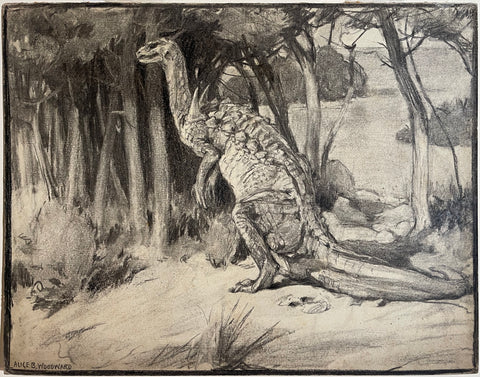
Alice B. Woodward (British, 1862-1951), Scelidosaurus From remains found in Lower Lias of Charmouth, Dorset. Length from snout to Tail-end, about 12 feet
Alice B. Woodward (British, 1862-1951)
“Scelidosaurus From remains found in Lower Lias of Charmouth, Dorset.
Length from snout to Tail-end, about 12 feet”
Preparatory drawing for “ Scelidosaurus” in Evolution in the Past page 92
Charcoal pencil on paper-faced pasteboard
Signed ‘Alice B. Woodward’ lower left
Board size: 7 3/4 x 10 5/8 in.
Scelidosaurus, or “limb lizard”, derives from Greek “skelis” meaning “rib of beef” and “sauros” meaning “lizard” is a genus of herbivorous armoured ornithischian dinosaur from the Jurassic of the British Isles. Scelidosaurus lived during the Early Jurassic Period, during the Sinemurian to Pliensbachian stages around 191 million years ago. Its fossils have been found in the Charmouth Mudstone Formation near Charmouth in Dorset, England, and these fossils are known for their excellent preservation.
Scelidosaurus is the most completely known dinosaur of the British Isles. During the 1850s, quarry owner James Harrison of Charmouth, West Dorset of England found fossils from the cliffs of Black Ven between Charmouth and Lyme Regis, that were quarried, possibly for raw material for the manufacture of cement. Some of these he gave to the collector and retired general surgeon Henry Norris. In 1858, Norris and Harrison sent some fragmentary limb bones to Professor Richard Owen of the British Museum (Natural History), London (today the Natural History Museum). Owen intended to call the dinosaur “hindlimb saurian” but confused the Greek word skelos, “hindlimb”, with skelis, “rib of beef.” The name was inspired by the strong development of the hind leg.
ALICE WOODWARD (BRITISH, 1862-1951)
Alice Woodward is perhaps more widely known as a children’s book illustrator, an “acceptable” field for female achievement in her lifetime. Still, she should be known as one of the pioneer artists in paleoart, imagery that depicts what life on Earth might have been like millions of years ago.
Alice was the daughter of Henry Woodward, keeper of the Department of Geology at the British Museum and President of the Paleontographical Society from 1895 to 1921. Henry encouraged all his children to draw. As was the climate of the times, his daughters became artists and his sons became scientists.
Alice prepared illustrations for her father’s lectures and colleagues’ papers by her late teens. Through these associations and her father’s encouragement, she was eventually tapped to produce images for the critical publications Henry Knipe’s Nebula to Man (1905) and Evolution in the Past (1912). Knipe, a colleague of Dr. Woodward, chose each illustrator for their reputation for scientific authenticity— particularly bird artists, given the many similarities between bird species and dinosaurs.
Drawings prepared for Knipe’s publications contributed to one of the most important publications on dinosaurs during what is frequently referred to as the “Second Rush” of the Great Dinosaur Rush or Bone Wars. The first Bone Wars occurred between 1877 and 1892 between Edward Drinker Cope, the Academy of Natural Sciences Philadelphia, and Othniel Charles Marsh, the Peabody Museum of Natural History at Yale. These early paleontologists fought ruthlessly to pursue dinosaur fossils, a quest that resulted in an extraordinary period of discovery and the eventual financial ruin of both scientists. Their findings resulted in unearthing 136 new dinosaur species, ushering in a new era in paleontological research.
While still not a household name in paleoart, we should continue to delve into the history of Alice Woodward, an interesting artist who took textural descriptions of a species never seen by humankind and developed them into a form. It takes astounding intelligence to create a vision of a species in the setting of a world so foreign to modern man and make it real in a remarkably tangible manner. Knipe acknowledged Alice’s pictures as a document of science in the preface to Evolution in the Past, writing, “I acknowledge with gratitude the valuable expert assistance which Miss Alice B. Woodward provided at the British Museum (Natural History.) Her pictures thus possess a real scientific value in addition to their artistic merit.”
ORIGINAL WATERCOLORS PREPARED FOR HENRY KNIPE’S
NEBULA TO MAN (1905) & EVOLUTION IN THE PAST (1911-1912)
An exceedingly rare collection of original watercolors prepared for Henry Knipe’s Nebula to Man (1905) and Evolution in the Past (1911-1912) by naturalist-artists Alice Woodward, Josef Smit, and Charles Whymper.
Drawings prepared for Knipe’s Nebula to Man (1905) contributed to one of the most important publications on dinosaurs on the heels of the Great Dinosaur Rush or Bone Wars. The Bone Wars occurred between 1877 and 1892 between Edward Drinker Cope, the Academy of Natural Sciences Philadelphia, and Othniel Charles Marsh, the Peabody Museum of Natural History at Yale. These early paleontologists fought ruthlessly to pursue dinosaur fossils, a quest that resulted in an extraordinary period of discovery and the eventual financial ruin of both scientists. Their findings resulted in unearthing 136 new dinosaur species, ushering in a new paleontological research era.
According to Henry Knipe’s obituary, he worked for the British Museum. It was there that he likely met the artists tapped for this project. Knipe chose each illustrator for their reputation for scientific authenticity—namely, those skilled as bird artists, given the many similarities between bird species and dinosaurs.
We Also Recommend

![Albertus Seba (1665-1736) Tab I [Insects]](http://aradergalleries.com/cdn/shop/products/I_large.jpg?v=1635434052)
![Albertus Seba (1665-1736) Tab II [Insects]](http://aradergalleries.com/cdn/shop/products/II_large.jpg?v=1635434726)
![Albertus Seba (1665-1736) Tab III [Insects]](http://aradergalleries.com/cdn/shop/products/III_large.jpg?v=1635434877)
![Albertus Seba (1665-1736) Tab L [Insects]](http://aradergalleries.com/cdn/shop/products/L_b_large.jpg?v=1635435506)
![Albertus Seba (1665-1736) Tab L [Insects]](http://aradergalleries.com/cdn/shop/products/L_large.jpg?v=1635437893)